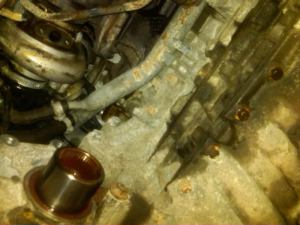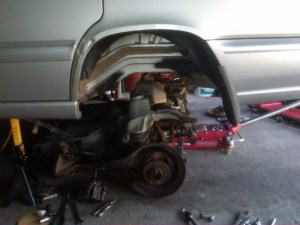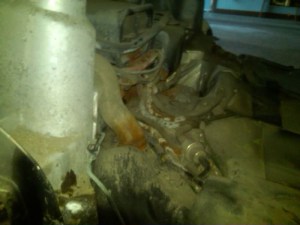 For many '98-00 Volvo owners, faulty propshafts present a difficult decision. Replace and wait for something else to go wrong, or remove and have a perfectly functional FWD vehicle? While complete AWD removal is a bit extreme, I've gotten a lot of questions asked regarding how I did it.
For many '98-00 Volvo owners, faulty propshafts present a difficult decision. Replace and wait for something else to go wrong, or remove and have a perfectly functional FWD vehicle? While complete AWD removal is a bit extreme, I've gotten a lot of questions asked regarding how I did it.
AWD Pros/Cons
I am a huge proponent of AWD, when it works. Unfortunately, my '99 S70 AWD arrived in my garage without a driveshaft, so I've never actually experienced the system first hand. After reading the horror stories online about angle gear/collar failure and viscous coupling issues, I decided to take on a little project. I had a perfectly good Subaru as my daily driver, and many hours to kill in the garage. Volvos were a new platform to me at the time, and I figured I'd get 1-2 extra miles per gallon as a small benefit. Looking back, I could have just as easily installed a new propshaft and had a great AWD vehicle, but that's water under the bridge now. I thought the system was in worse shape than it was.
Take note that this is not a common procedure, and there is almost no reason to remove the entire AWD system from the front to the back in most cases. If anyone can learn useful information from this article, then I'm happy to have written it.
Ripping things out
What's the AWD system comprised of?
- AWD-Specific Transmission
- Angle Gear (Transfer Case)
- Propshaft
- Viscous Coupling
- Rear Differential
- Rear Axles
First, the angle gear came out. I popped out the passenger side axle, removed the oil cooler, removed 5 or so bolts, and out it came.
[gallery columns="2" ids="4120,4119"]
This left me with a splined collar that would pop out of the transmission if I drove the car. Solution? Red loctite. I removed the collar, cleaned the splines thoroughly, and re-installed it with red loctite. It was solid. So solid, in fact, that I needed a puller to remove it later on down the road. If you're looking to do an angle gear delete, don't be afraid of the loctite.
Okay, the front's done. With the passenger side axle re-installed, my AWD transmission suddenly was FWD. I could have stopped here. I already went too far, the angle gear was totally fine. What's wrong with me?
The Fun Part
Rear differential and axle removal saved this car a ton of weight. I don't regret it one bit, even though it was a terrible job on a garage floor. I consider myself extremely lucky that no negative effects have cropped up, it really turned out well.
Here's the gist of it:
- Remove rear axle nuts
- Remove the rear brakes
- Remove e-brake cables from rear hubs
- Disconnect fuel pump/ABS/EVAP connections in the trunk
- Remove the metal ring holding the filler neck to the body, behind the fuel door
- Remove the single large bolt holding the viscous coupling to the body
- Remove 6 bolts holding the subframe to the vehicle
- Lower subframe and cry
The differential is held in by an aluminum plate above it; a bunch of small bolts hold it in. The EVAP system lies above this plate, but it can easily be unbolted and pushed out of the way. With the plate removed and differential wiggling around, it should be easy to pop out the rear axles. Then, I had a burly friend help me drag out the dead lump of differential to free it from its confines once and for all.
[gallery ids="4126,4129,4128"]
How did I keep the bearings happy?
Wheel bearings that are designed to have axles in them, should always have axles in them. It's essential for bearing life. So how did I keep the bearings happy? I took apart the axles and kept the outer cups inside the bearings, with the axle nuts torqued to the original spec. The bearings are none the wiser.
On the bright side...
There were a few great benefits to removing the rear subframe.
- Fuel pump replacement was cake
- I found leaky fuel and EVAP lines that were easily replaceable with the subframe down
- I was able to wash the top of the fuel tank. A huge worry on my mind, lifted.
I'd have to estimate that I removed around 120-140lbs of dead weight from the vehicle. The car seemed a tiny bit quicker afterwards, but I don't know, probably not, no. No it wasn't. Gas mileage also probably went up, I'll never know. Screw it.
[gallery columns="2" ids="4130,4127"]
Should you do this?
In the quest for speed, we're always looking to shed some pounds in the name of acceleration and handling. However, I have to rate this project a 2/10 on the usefulness scale. These parts sit so low in the chassis that handling was hardly affected at all, and the weight saved was that of a small woman. Waste of time? Nah, I learned a lot, but would never do it again. AWD is just too useful.
Alex is FCP's Blog Editor and an IT technician from Endwell, NY. He has over 8 years of experience working on a wide array of import makes, but lately is partial to Volvo . For some reason he just purchased a Volkswagen, and is excited to see what breaks first.















